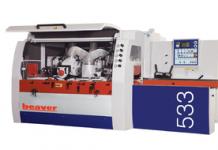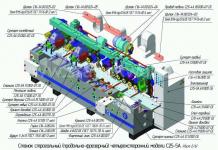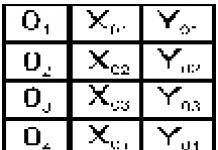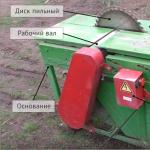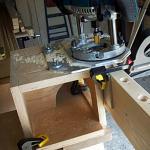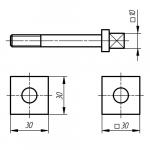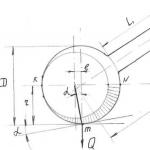Contents:
Circular-type machines belong to the class of specialized processing mechanisms, without which no well-equipped home workshop can do.
This example of woodworking equipment is especially relevant in the conditions of a country house and country house.
When assessing the possibilities of purchasing ready-made equipment, you will encounter a number of problems associated with the inconvenience of handling cheap stand-alone circular saws and the prohibitive cost of professional processing equipment.
The only correct approach to solving this problem is to make a circular saw with your own hands, using materials and equipment that are commercially available.
Note! In order to save money, in small-sized models of machines, an autonomous circular saw, which is rigidly mounted on the bed, is most often used as a cutting tool.
Using a homemade machine, you can saw boards, plane slabs, and also make bars of the desired cross-section.
If desired, you can significantly expand the functionality of your product by providing it with the ability to process wood using an electric planer.
Design requirements
Before starting work, it will be necessary to prepare a small sketch, which should indicate not only the location of all the structural elements of the future machine, but also their main dimensions. When drawing such a sketch, you should take into account that your circular saw may consist of the following functional units:
- bed, which serves as the basis of the entire product;
- tabletops with an industrial prototype of a hand-held circular saw installed on it;
- remote control panel for turning on and off the actuator (circular saw).
Small-sized tabletop circular saw
The specified composition of the machine is typical for small-sized products on a wooden frame. For capital equipment manufactured on the basis of metal profiles (angles), its diagram has a slightly different form. Such a product must include the following elements:
- a base made of steel frames and brackets on which a shaft with a drive pulley is mounted in bearing pairs;
- a table top with slots for the processing blade, installed on top of a metal frame and rigidly fixed to it;
- a set of special drive electrical equipment located in the lower part of the frame and providing the required functionality of the device (it includes an electric motor, a starting device and a transformer-converter).
The main requirement for any type of frame is to ensure maximum reliability and stability of the structure. As options for the machine base, we will consider both frames made of metal profiles (corners) and load-bearing structures made of wood.
When familiarizing yourself with the requirements for the electrical equipment of a homemade machine, first of all, you should determine the drive power of the cutting tool (or autonomous saw), which for domestic conditions should not exceed 850 watts.

Stationary circular saw
In addition, before preparing a sketch of the future product, the technical characteristics of the equipment used should be taken into account, such as:
- The depth of cut, which specifies the permissible thickness of wood pieces to be processed on your machine. This figure for industrial samples of woodworking equipment ranges from 5 to 8 cm, which is quite enough for cutting standard boards and thick plywood.
Additional information: In the event that you need to process wood blanks of greater thickness, it is necessary to provide a special lifting mechanism in the frame that allows you to change the position of the disk in height.
- Before manufacturing a capital machine with a separate drive, the operating speed of the electric motor rotor should be taken into account. The choice of this parameter is determined by the lumber processing modes with which you will most often have to deal. For simple cutting of wood pieces, this figure can be relatively low, but to obtain a perfectly smooth (“clean”) cut you will need a higher rotation speed.
Important! The optimal speed for homemade cutting machines is considered to be a rotation speed not exceeding 4500 rpm. At low engine speeds, the frame can be made on the basis of a reinforced wooden frame, massive enough to prevent vibrations of the mechanism.
- When drawing up a sketch, ergonomic requirements should also be taken into account, implying ease of control of the operation of the equipment, as well as safe handling. They relate to the order of the buttons on the operating panel, restricting access to the cutting blade, as well as the electrical security of the drive or individual controls.
After all possible requirements for the future machine have been taken into account, you can begin to assemble it directly.
Bed based on metal profiles (corners)
It is most convenient to make the upper part of the metal frame in the form of a rectangular frame 600 by 400 mm, welded from 25 mm corners. Pipe blanks 220 mm long are welded to the four corners of this structure (recommended pipe diameter is 17-20 mm).

The bed must ensure rigidity of the machine structure
Two longitudinal angles are fixed to the frame using bolts, used to secure the shaft in the bearing race.
The distance between the angles is determined based on the length of the shaft, and the bearings used for installation are secured to them with special clamps.
In order to give it greater stability, the lower part of the frame frame is made (welded) from 40 mm metal corners.

A closed type bearing is used to secure the working shaft.
Two jumpers made of the same material are welded across the frame, used to secure the electric motor. There is also a metal platform intended for mounting launch equipment.

Bearings are attached to the frame using special clamps
At the corners of the resulting structure, pipe blanks are welded with a length corresponding to the size of the pipes on the upper frame, but with a slightly larger diameter (23-25mm).
Closer to their edge, special clamps (wings) are made, used to clamp the lifting pipes of the upper frame, which are moved when the drive belt is tensioned.
The procedure for assembling the mechanical part of such a machine includes the following operations:
- first, bearings No. 202 are taken and driven forcefully onto the working shaft;
- after that, a pulley, previously turned on a lathe and having an internal groove diameter of 50 mm, is fixed on the same shaft with tension;
- then at the end of the shaft a thread is cut for the bolt used to clamp the cutting tool (for more reliable fixation, paronite and metal washers can be placed under the bolt);
- upon completion of this part of the work, we proceed to installing a drive manufactured on the basis of a three-phase asynchronous motor with a power of 1.5 kW (1500 rpm). A pulley with an internal groove size of approximately 80 mm is mounted on the shaft of such an engine;
- at the next stage of assembling the frame, the two finished halves of the frame are connected together (in this case, pipes of a smaller diameter are inserted into larger ones);
- At the end of the work, the belt is tensioned on the shaft, and then the structure is fixed in this position using special “wing” clamps.
Machine on a wooden frame
The simplest and most affordable way to make a machine bed involves using ordinary boards or thick plywood for this purpose. In this design option, the executive unit is placed directly under the table (tabletop), in which a slot of appropriate dimensions is made for the cutting blade.

The wooden frame is reliable and easy to manufacture
As an example, we will consider the option of manufacturing a frame with a height of approximately 110 - 120 cm, intended for attaching a hand-held circular saw to it. The length of a tabletop of this design can be changed within small limits at your discretion.
Note! The height of the structure can be adjusted if desired, taking into account the height of the person working on the machine. And if it is necessary to process very long boards on it, the dimensions of the tabletop can be increased to the required size. In this case, you will have to worry about installing additional support legs.
The most convenient material for making countertops is multilayer plywood with a thickness of at least 50 mm. However, other materials can be selected for these purposes (plexiglass or fiberglass slabs, for example). As for such a common material as chipboard, its use in this case is undesirable, as it does not provide sufficient surface strength.
To make a machine on a wooden base, you will need the following materials:
- sheet metal preparation;
- standard sheet of thick plywood;
- a pair of beams with a cross section of 50×50 mm;
- thick boards with a standard size of 50 x 100 mm;
- steel corner required to increase the rigidity of the guides;
- a circular saw;
- two clamps.
In addition, you will have to stock up on the following set of tools, without which assembly of the machine is simply impossible:
- classic screwdriver and electric drill;
- a simple wood hacksaw or jigsaw;
- measuring instruments (square, tape measure, ruler);
- portable milling cutter for wood processing.
If you don’t have such a milling machine, you can use the help of friends or neighbors who have a milling machine on their farm.
Additional Information: Some home craftsmen prefer to make countertops from used kitchen tables. However, such a design will not be durable, since the source material was used for a long time in a damp room. That is why it would be wiser to manufacture all structural elements from new blanks, which at the same time will allow you to take into account your personal tastes and preferences.
Making a countertop
Work on the manufacture of this part of the equipment is carried out in the following sequence:
We start by marking a piece of plywood so that its edges are flush with the edges of the prepared sheet of iron. After marking, using a hacksaw or electric jigsaw, you can cut the plywood blank to the required size. If desired, you can process its edges using a cutter, although this is not at all necessary (the main requirement for this element is its reliability, not attractiveness).
Upon completion of these operations, the surface of the tabletop is carefully processed (rubbed) with medium-grain sandpaper.
Then, on its lower part, the location of the slot for the saw blade is preliminarily marked. To do this, it is necessary to determine the dimensions of the sole of the circular saw prepared for installation. To make measurements easier, the blade is simply removed from the saw, after which you can easily determine the dimensions of the seat.

For ease of marking the tabletop, the saw blade is removed
Upon completion of its preparation, you should take a circular saw and try it on at the installation site. If necessary, the position of its attachment points is adjusted (at the same time, the contours of the slot for the saw blade are specified).
The finished plywood table top is covered with a steel sheet attached to it using self-tapping screws. Subsequently, it will be possible to apply special markings to the working surface, allowing the position of the wood piece to be adjusted during its processing.
Frame assembly
Both transverse and longitudinal frame beams, used as stiffening ribs, are also mounted on the lower plane of the tabletop. A total of four such strips will be required:
Two transverse lintels that do not reach the edge of the tabletop by 7-9 cm on each side.
Two longitudinal bars, the size of which corresponds to the same condition (they should not reach the edges of the tabletop by about 7-9 cm).
Taking into account these restrictions, it is necessary to mark the fixation points of the longitudinal bars and crossbars, at which the latter will be attached to the tabletop using self-tapping screws of a suitable size.
When marking points, the outermost one is selected at a distance of approximately 40-50 mm from the edge of the block (in this case, the step between them should be about 23-25 cm).
Before the final assembly of the frame, through holes for self-tapping screws are drilled in all component parts (bars and table top). On the front side, the fastening elements are installed in such a way that their caps are completely hidden in the material.
To increase the strength of the future frame base, the bars adjacent to the tabletop are pre-coated with wood glue.
After assembly, the structure is temporarily fixed using clamps, which can be removed after the glue has dried.
Attaching the support legs
The table legs are made from bars of a suitable cross-section (most often the same 50x50 mm blanks are used for these purposes). The height of the supports is selected for a specific person, i.e. individually.
This should take into account the fact that it is more convenient to work on a circular saw when the tabletop is at hip level. Before their final installation, the shape of the legs is modified so that they taper towards the supporting part (the area of contact with the frame base must exceed the area of support on the floor).
To increase the rigidity and stability of the structure, steel corners can be used, which are pressed in such a way as to provide additional “strut” for the base. To secure them, special bolts with washers are used, installed with their heads facing outward.
Electrical diagram
In the capital version of the circular saw design, an autonomous drive is used, which includes an asynchronous electric motor, the windings of which are connected to the electrical network according to a triangle diagram.

Wiring diagram for an asynchronous motor of a circular machine
To control the operation and ensure automatic starting of the electric motor, the circuit provides a magnetic starter built on the basis of an electronic switch (triac) and a current transformer.
To build a control circuit for a machine on a wooden frame (an option involving the use of a hand-held circular saw), it will be enough to duplicate the on and off buttons of the mechanism, bringing them out and securing them to one of the legs of the tabletop
You will learn more about connecting the machine's electric motor from the video.
A circular saw is required in private households quite often, but it is not at all necessary to buy an expensive tool for this. You can make a circular saw with your own hands from available materials.

Basic materials and tools
To create a circular saw you will need the following materials:
- pipe (45 mm);
- channel;
- corner “4” and “6”;
- boards 30 mm wide;
- metal sheet up to 8 mm thick.



The nodes you will need are:
- engine;
- bearings.


The work cannot be done without tools and materials:
- jigsaw;
- turbine;
- screwdriver;
- screwdriver;
- scotch;
- hammer;
- wire cutters;
- pliers;
- tape measure and triangle ruler.




How to do it yourself?
You can make a circular electric saw for wood with your own hands from various devices. There is an important condition: you must have metal working skills.

From the Bulgarian
Making a homemade stationary circular saw at home is not difficult. First of all, you should decide on the project, draw a diagram and make a drawing. The differences between a stationary and tabletop DIY circular saw are the height of the base. Before assembling the instrument, you should think about creating a “table”. It is usually made of wood (board thickness - 3 cm) and covered with tin or aluminum sheet. Steel sheets up to 6 mm thick can also be suitable for these purposes. Cross members are made from angle iron (up to 80 mm).

The working disk protrudes beyond the table usually by 35%, that is, for a beam 120 mm thick, the diameter of the disk should be 370 mm, respectively. The power plant required will be 1000 watts (possibly more). If the workpieces are more massive, then a homemade circular saw may not “take” them. The support is created from the angle “8” - this is a fairly massive and durable structure that can withstand quite significant loads. The stop extends beyond the table by 4-5 cm. One shelf is processed on both sides, the remainder in this case should be equal to the length of the table.

A very important unit is the shaft - it is best to take it ready-made. If you have the skills to work on a lathe, then turning such a part is not very difficult. You will need to buy bearings with protection. It is better to use a V-belt pulley. A power plant from a refrigerator or washing machine can be used as an engine. Capacitors are usually made of oil and paper.

After you have managed to assemble the machine using available materials, you should test it without any loads. All elements must “get used to” each other in order to work as a single complex. During the testing process, some shortcomings may appear, they will need to be eliminated. For a homemade circular machine, a motor from a washing machine may be ideal.

Such power plants operate from a 220-volt network; they have good efficiency and an acceptable rotation coefficient. If you install a three-phase motor (it is powered by 380 volts), you will have to buy additional capacitors to reformat the unit to 220 volts. Sometimes they use units with a gasoline engine - such power plants have good efficiency and are unpretentious during operation.

The most important element in a homemade unit is the shaft. You can grind it yourself from a metal pig. It is not difficult to make such an element on a lathe. It is important to maintain the centering of the part so that there is no unnecessary vibration of the mechanism. Special grooves are machined on the shaft where the saw blade and pulleys will be attached. Sometimes recesses for attaching knives are also machined. The size of the saw blade itself is directly related to the power of the engine. The diameter should be 3.5 times the thickness of the product. There are also proven calculations: for 110 mm of material thickness, an engine power of 1 kW will be required.

Craftsmen often make a circular saw together with a jointer on the same base. In this case, both tools can work from the same engine. A jointer is capable of cleaning a wooden surface to a mirror shine; its presence in combination with a circular saw is more than appropriate.
From a hand-held circular saw
It is also easy to assemble a circular saw from a hand-held circular saw. The sliding stop can be made from angles that are mounted on both sides of the rotating element (disc with teeth). The slot width is usually up to 5 millimeters. All edges must be processed so that they are slightly rounded. All corners are made with crossbars that should bind them tightly. You can use bolts and nuts as fastenings.

A metal clamp should be attached to the body. The screw tie is mounted at the bottom of the block. The clamp (thickness up to 2 mm) in conjunction with the rear pillar is a single unit that can withstand significant loads. The stop is fixed at the rear of the unit. The washers that create the gap can be moved by adjusting the size of the slot between the disk and the sides of the stop.

It is best to do the transmission using lino belts - if a foreign object gets in, then when jammed, such pulleys will slip, which eliminates the possibility of injury. A pulley with a larger size is placed on the engine, a pulley with a smaller diameter is placed on the circular shaft - in this ratio the optimal number of revolutions is achieved.

From a chainsaw
To make a circular saw from a chainsaw, you will need a metal canopy that will be mounted to the body of the saw. The engine is already available, so making the unit will not be very difficult. You will also need two channels measuring 185x8000 mm. You will also need corners (55 x 100 mm) and two pieces of rails that turn with their soles up. Holes of 16 mm are drilled at the base of the sawmill, with a distance of one meter between them.

Ties are made from pipes (length - 255 mm). The structure is fastened with bolts. The racks are made separately; the sawmill body will be attached to them. It is important to ensure that all elements are not deformed. The distance between the posts should be no more than one meter. Then the sawmill is equipped with a movable carriage. It is made from a steel sheet 620x55 mm, corners are welded to the metal from below. Small bearings are mounted on the trolley. Two corners should also be welded at the top, and a chainsaw is attached to them. Then a holder is made that will work as a clamp for a beam or log.

You will need a pipe with a diameter of 45 mm. To work, you will need a hose that will be mounted at a given height, which should not be greater than the length of the pipe itself. This is how a sawmill is made. Such a unit can process timber or logs of any cross-section.
From a drill
The drill is a universal tool, from which the following units can be made:
- mini drilling unit;
- lathe;
- mower;
- turbine.

Mechanics at service stations even make winches out of drills to lift fairly large loads. The drill is also actively used in construction, in particular in painting work. Farmers often use a drill to install seedlings in the ground. The circular from the drill will be compact. To create the tool you will need the following elements:
- bases made of boards 2-3 cm thick;
- vertical supports;
- the shaft on which the disk is mounted;
- electric drive in the form of a drill.

Instead of boards, you can also use chipboard sheets with a thickness of at least 30 millimeters. On such material you should cut a rectangle measuring 310x255 mm. Also for the desktop you will need a 5 mm thick duralumin sheet. This material is good because it has an acceptable stiffness coefficient and at the same time low weight. A hole measuring 165x12 mm is cut in the place marked with a marker.

You can also make the fasteners for the drill itself yourself. The assembly for the shaft with the saw can be easily found on any construction market. During operation, a lot of dust will arise, so you should look for a bearing with protection - this will significantly extend its service life. A circular saw from a drill is assembled according to a standard algorithm:
- all main parts are attached to the base;
- then the table is mounted;
- the drill is connected, tests are done.

The equipment requires compliance with safety precautions:
- the work area should be cleared;
- the workpiece should work smoothly, without any delays;
- the machine must be equipped with a protective screen;
- garbage should not accumulate on the machine, it should be removed in a timely manner;
- You should do a preventive inspection of the unit and lubricate it.

This mechanical device makes it possible to process not only wooden products. If you install good cutters, you can work with non-ferrous metals, PVC, chipboard, and bars.
Homemade devices
Making a circular saw is not that difficult; problems may arise when fitting the components. Choosing all the elements correctly so that they work flawlessly is an important task. The shaft must have self-adjusting bearings if the unit is used daily. It is best to select the bearings themselves with two rows of balls, which will be adjusted using a clamping nut.

The working surface must have a “grid” marking. Without this coordinate system, accurate woodworking is quite difficult. The protective casing must not be neglected - during operation it reliably protects the device from mechanical damage. A circular saw operates in different modes when working with different materials, so it is advisable to have a device that controls such a process. Several grooves should be made on the shaft so that it is possible to rearrange the pulleys, thus changing the speed.

The parallel fence is a necessary device for working with large workpieces. You can make them yourself from plywood, boards or chipboard. The stop size usually does not exceed 25 mm. The stop is attached using self-tapping screws or bolts.
When you have to saw bars or make several cuts from different directions, you need a stop that has a “P” configuration. At its base lies a board 30 mm thick. Sidewalls 12 mm thick are screwed to the base. Thus, the emphasis is installed on a beam, the size of which from the cutting point corresponds to the size of the cutting disc. On both sides it is pressed against the beam with clamps. If the beam is too massive, then it is rearranged and another cut is made.

There is also an edge stop that is in demand. To make it requires a lot of time and good qualifications of the craftsman. Be sure to make a diagram before starting work. This stop is made from plywood (20 mm), and the stop strip is also made from this material. Manufacturing phases:
- longitudinal grooves for keys are cut;
- the keys are mounted on a thrust strip;
- Another groove is cut between the grooves made to secure the thrust strip;
- another hole is made in the base, its size corresponds to the saw blade of a circular saw;

Sidewalls-limiters are mounted, and there must be clamps in order to securely fasten them. To place the emphasis on the workpiece, the bar moves in the grooves and is fixed through the slot with clamps. It is best to immediately attach a ruler or tape measure to the frame - this makes the work much easier. The pusher is convenient for working with small workpieces - it allows you to fasten the part on both sides, which ensures precision in work. It is also important to do:
- elevator;
- riving knife;
- lifting mechanism.

If a three-phase motor (380 volts) is installed on the machine, then capacitors that can withstand a minimum voltage of 620 volts will certainly be required. These devices may be paper-based.
Capacitors are calculated according to the following scheme: per 1000 watts there are 100 µF for a working type capacitor. The capacity of the starting capacitor must be ordered twice as large. It should be remembered that the SB starting block is a device that automatically returns to its original position. This is very convenient, since literally a few seconds after the start you can begin the workflow.

- you cannot work with wood that contains metal fragments (nails, screws, etc.);
- marking the material is possible only with special clamps or substrates (this is especially true for long boards and timber);
- boards and timber from two meters in length must be processed by two people;
- when working with the disk, no sudden movements or jolts should be used, otherwise the device may jam or break;
- if the material has dimensions of 42 cm or more, it is recommended to use a special pusher;
- if the wood is heterogeneous (there are branches and knots), then it must be dissolved before work;
- You should always use gloves: both during operation and when cleaning the unit;
- Do not accumulate wood waste on the machine - this may cause a fire or short circuit.

The machine cannot be operated under the following circumstances:
- no guide bar;
- no casing;
- the gap is too wide (from 10 mm);
- there are no safety devices (raking cutter, holding fingers) that protect the worker from the workpiece falling off;
- the height of the riving knife exceeds the height of the saw blade (from 6 mm), the distance of its installation (17-110 mm).

The machine must have a chip collector. Be sure to wear safety glasses while working. When changing elements on the machine, it must be de-energized.
To learn how to make a circular saw with your own hands, see the following video.
A circular saw is specialized equipment that is used for cutting wood, laminate, some types of wall panels, sheet materials such as plywood, OSB, chipboard. When carrying out a number of construction and repair work and carpentry operations, the presence of a stationary sawing installation can significantly reduce time costs and improve the quality of the result. If it is not possible to purchase a factory-made model, then you can assemble a circular saw with your own hands. To make it yourself, you will need the most common metalworking tools and the skill to work with them. The more necessary materials and parts are available, the cheaper the project will cost.
A stationary circular saw is designed to perform fairly large volumes of work. The design of the implemented option in two forms is presented in the diagram below. It also indicates main installation dimensions, which are recommended to be used as a starting point for self-assembly.
In the drawing, the numbers correspond to the following structural elements of homemade equipment:
- 1 – frame (bed);
- 2 – side panel;
- 3 – starting device;
- 4 – mechanism for adjusting the height of the table, 13 – its stops;
- 5, 6 and 7 – two halves of the sawing table with a base;
- 8 – electric motor;
- 9 – platform for installing the motor;
- 10 – studs (M10);
- 11 – saw;
- 12 – shaft;
- 14 and 16 – driven and driven pulleys, respectively;
- 15 – belt;
- 17 – switch.
Advice! To improve personal safety when operating a homemade mechanism, its rotating parts located under the table should be covered with lids. A protective cover must be installed over the disk during equipment downtime.
It is better to place the starting device in a visible place on the panel (made of dielectric material) so that access to it is free. It is also recommended to equip the machine emergency switch. It is convenient when it is large in size.

Focusing on your own needs, you can improve the unit by making it with a jointer or planer. To do this, it is enough to secure a drum with knives on the existing shaft, and make a slot of the appropriate size in the table for it. This will allow you to expand the functionality of the created installation: plan lumber on it, chamfer and select a quarter from wooden blanks.
If you plan to regularly perform carpentry operations using homemade equipment, it is recommended to equip it with coordinate table with several guides. They need to be fixed at different angles. To organize productive work, it should also be possible to regulate the speed of the electric motor and quickly replace disks if necessary.
Selection of materials and parts
When creating a homemade circular saw, it is necessary to maintain an optimal balance between its functionality, safety during operation and manufacturing costs. To achieve this, you should select materials and parts with the desired characteristics. To reduce costs, you need to start from old or unused equipment that is available.
Materials for making a bed with a table
To make a bed (frame) you can use channel or metal corners(sizes from 25×25 mm to 50×50 mm are sufficient). If these materials are not available, then the most economical option is to purchase them at a scrap metal collection point. The legs of the machine will use water pipes or profile metal pipes.
Advice! Frame elements must be connected to each other using electric welding, because bolted connections unwind under the influence of vibrations.
When assembling the frame, it is also necessary to weld spacers at the corners to impart rigidity to the structure. To make it easier to move the machine, you can equip it with durable wheels (with a metal rim) equipped with locks. It should be borne in mind that the more massive the unit being created, the more stable it must be in order to avoid injury.

Metal pipe frame
The main requirements for a table for a circular saw: resistance to mechanical influences (vibration, shock), the ability to withstand workpieces weighing more than 50 kg without deflection, and surface smoothness. These properties characterize sheets of the following materials:
- become;
- duralumin;
- silumin;
- PCB;
- moisture-resistant plywood;
- organic glass.
If you use moisture resistant plywood, then it should first be covered with zinc-coated sheet metal. The use of chipboard or OSB is not recommended due to the instability of these sheet materials to vibration influences.
Important! The strength of the table is of great practical importance. If it cracks or becomes distorted due to deflection, the disk may jam. This can lead not only to damage to the workpiece, but also to injury.
To carry out various work (for example, cutting logs into boards), you need to equip a table side stop. It performs the same function as a guide bar for a hand-held circular saw: it ensures even sawing of lumber. Moreover, its use makes it possible to obtain workpieces of different sizes.

Guide stop must be strictly parallel to the disk to avoid jamming of the latter. It can be made from a wooden block or a metal corner. In the first case, only hardwood should be used. To be able to adjust the working gap, the stop must be removable. It can be fixed using clamps or in special grooves (bolts) made parallel to each other on the working surface of the tabletop.
Selection of engine and starting equipment
The easiest way to use a drive for the considered version of a homemade circular machine is single phase electric motor. Its power must be selected taking into account the upcoming load. Indirectly, you can navigate by the diameter of the installed disk:
- if it is 350 mm, then for normal operation of the unit you need an electric motor with a power of 1000 W;
- for a disk with a diameter of 170 mm, a 500 W motor is sufficient.
In the latter case, you can make a drive mechanism from an engine from an automatic washing machine. It is able to work for a long time at an average load level. For disks with a diameter of 350 mm, an electric motor from an industrial ventilation unit is suitable. It should be secured firmly to ensure proper engagement of the belt drive. For this reason, it will not be possible to reduce the level of vibration by installing the motor on shock absorbers: it will constantly oscillate.

You can also equip homemade equipment three-phase electric motor(at 380 V) of suitable power. To start it from a 220 V network, you will need to additionally install working (phase-shifting) and starting capacitors into the electrical circuit. It should also be taken into account that the engine power will be less than the nominal value indicated on its plate or in the passport.

Starting equipment should be selected based on the power of the motor, on which the maximum current in the circuit will depend. A good option is to use a start button in conjunction with thermal protection - this will protect the electric motor from burning out the windings if the current increases when the disk jams. It is better to install the protection in a separate electrical panel attached to the side panel of the machine on the convenient side.
All connections must be well insulated so that the wires do not short-circuit to the frame of a homemade circular electric saw. The on and off buttons should be pressed without any effort. Due to the frequent storage of equipment outdoors, the electrical part must be well protect from getting wet. The simplest thing is to cover the installation with oilcloth or similar waterproof material.
Gear, shaft and disc
To transfer rotation from the electric motor to the disk, the best option is to use V-belt together with pulleys from the car engine. The use of gears is not recommended for safety reasons. This is due to the fact that if the disk jams, the belt will simply slip, and the gear drive, due to its rigidity, can cause failure of the entire drive unit.
Advice! If you use pulleys of different diameters, you can change the speed of the disk and install different types on the machine. This is true if there is no motor speed controller.
Shaft manufacturing It is better to entrust it to a specialist by ordering it from a professional turner. Moreover, when you plan to make a circular electric saw more functional by equipping it, for example, with a plane. But the simplest option is to buy a ready-made factory-produced part. A sample of it is shown in the photo below.

Disc for circular saw It’s easier to buy ready-made than to make it from a sheet of tool steel. The problem is one of balancing. An imbalance of the saw during operation of the equipment leads to its rapid failure and reduces the level of safety of the work process. If you have a circular saw for wood, you can remove the saw blade from it.

It is necessary that the diameter of the disk corresponds to the corresponding parameter of the sawn timber: for example, for 100 mm logs you will need to use a saw measuring approximately 350 mm. This is due to the fact that the disk should not protrude more than a third of its diameter above the working surface of the table.
Ignoring this requirement not only leads to a deterioration in the quality of sawing workpieces, but also increases the possibility of injury.
Algorithm for assembling a homemade circular saw
The assembly of a woodworking machine according to the drawing given earlier is carried out in the following sequence:
- a rectangular frame is made from the corners;
- four legs are welded to it at the corners of the required height;
- at a height of about 200 mm from their lower edge, they make a binding from the corners;
- a shaft is mounted on the upper frame;
- fix the driven pulley on one side and the disk on the other;
- a table with a lifting mechanism is made and attached to the frame;
- on the lower frame they make a platform from corners or sheet metal for the electric motor;
- the drive pulley is fixed on the motor shaft;
- put the belt on the pulleys;
- On and off buttons and an electrical panel are mounted on the side panel of the unit;
- using wires of a suitable cross-section, connect the elements of the electrical circuit of the equipment (motor, buttons, protection);
- supply power to the machine from a stationary network.
The final stage is checking the functionality of the assembled equipment. First, you should make sure that all moving parts rotate freely: to do this, simply twist the drive pulley by hand. After which you can start the unit in test mode. If strong vibration is detected, you will need to check the reliability of the bolted connections and fixation of the disk.
You can make a circular saw with a table consisting of two halves or a solid one. In the latter case, you will need to cut a rectangular slot in it for the disk. The design of the machine with a table consisting of two halves is shown in the video below. This video also demonstrates the design of the lifting mechanism for these parts.
Important! To prevent the possibility of the saw jamming due to the connection of fragments of the workpiece being cut, it is recommended to install a riving knife. It should be located at a distance of approximately 3 mm behind the disc.
To regulate belt tension, the electric motor must be installed so that it can be moved. The easiest way to achieve this is by creating larger slots than required for the motor mounting bolts. In this case, the expansion of the holes should be carried out in the direction of belt tension.
If you completely follow the drawing, you will need to make a more complex belt tensioning mechanism. The process will be carried out by pulling up the platform with the electric motor using studs and fixing it with locking bolts in the desired position (in the drawing these structural elements are indicated by the number 10).
The entire design and assembly process can be greatly simplified if circular saw blade. In this case, there is no need to install a number of parts (motor, disk, shaft, belt, starter). But the capabilities of the created model will be limited by the power of the tool used.

Homemade circular anyway must be grounded. It is also additionally recommended to install a residual current device or differential circuit breaker in the panel. These measures will protect against electric shock if the machine body is energized, for example, due to breakdown of wire insulation. It is better to select components for the electrical part of a circular saw so that they are suitable for repair and easy to maintain. Free access to equipment components will help you easily replace failed parts.
A circular saw for wood is a stationary piece of equipment with a round saw blade. In addition to the longitudinal sawing machine, the concept of “circular saw” also includes a pendulum saw (cross-cut device), which is distinguished by the mobility of the sawing disk fed to the fixed lumber.
Depending on the design of the unit, the following types can be distinguished into which circular saws for wood are divided:
- Tabletop type, suitable for home use. According to the name, it is placed on a table or on a workbench and weighs an average of 25 kg. After the work is completed, the machine can be hidden. The maximum straight cutting depth is 75 mm.
- Stationary type. Used in medium and large production, the maximum cutting depth is 125 mm. Using a stationary type of circular saw, the most accurate and high-quality work is performed.
- Circular saw with stand: it can be used to process long boards thanks to the folding stand. Folding legs allow you to transport the machine. The maximum cutting depth is 85 mm.
Additionally, types are distinguished according to the location of the saw blade:
- Horizontal sawing machines. The saw is located parallel to the bed.
- Vertical sawing machines. The cutting disc is located perpendicular to the bed, the saw can be open or semi-open.
- Angular type: two disks operating simultaneously are located at right angles to each other.
All of the listed types of equipment can be either professional or used for domestic use. The difference lies in the power of the machines, the number of accessories and additional options.
Wood circular design
Wood circular designIndustrial and household circular machines have a basic configuration. It consists of the following elements:
- Bed.
The main part of the table saw to which all other parts of the equipment are attached. The bed is usually made of cast iron or strong steel to ensure stability and vibration-free operation during operation, so as not to complicate the process. If the frame is made of wood, it must be fastened with stiffeners
- Working surface.
The table for placing the material to be cut is a working surface. As a rule, its upper part is made of metal or cast iron; guides and rulers are located on the surface for measuring lumber and ease of installation. The part of the working surface where the saw blade is located is usually removable - this makes it convenient to replace it. The slot for the saw must correspond to the thickness of the disk, otherwise, with a larger size, the slot will constantly become clogged with chips and sawdust.
- Disc for cutting
The thickness of the processed wood depends on the diameter of the saw blade of a circular saw or a wood saw. The disk should be installed in such a way that no more than 1/3 of its diameter protrudes above the working surface.
- Protective cover.
Professional equipment is usually equipped with a guard to protect the operator from contact with the saw blade, as well as to clamp the lumber.
- Riving knife.
This element is installed to simplify the sawing process, especially when processing improperly dried or knotted wood, which can cause the saw blade to jam. The riving knife is installed behind the saw blade relative to its working stroke.
- Longitudinal stop.
This element serves as a guide for even sawing of lumber. The longitudinal stop must be made of rigid material and not move during operation; this is why it is fixed in at least two places.
- Drive unit
The drive consists of a motor and a shaft onto which the saw blade is mounted. For high-quality processing of lumber, a two-phase or three-phase motor with a power of 1200-1500 W is required. The shaft for fastening the saw must have dimensions corresponding to the internal diameter of the disk and ensuring its tight and reliable fastening.
Homemade circular saws for wood with your own hands, photo
Homemade circular saws, if assembled correctly, can perform high-quality cutting of material and have a service life that is not inferior to factory models.
 Do-it-yourself wood circular
Do-it-yourself wood circular To assemble a homemade machine model, you will need the following materials and tools:
- A metal sheet
- Plywood
- Beam with a section of 50x50 mm
- Board 50x100 mm
- Steel corner
- Clamps
- Screwdriver, electric drill
- Measuring tools
- Hacksaw or jigsaw
A homemade circular must meet the following requirements:
- Capital rigidity and stability of the structure, on which the safety indicators of the equipment depend.
- Smooth work surface
- Machine grounding
- Free space for sawdust
- Free access to wood waste for its disposal
- The presence of a protective casing over the rotating disk.
When choosing a saw, you should take into account the requirements for high-quality and safe work: reliable fastening of the disk, fencing off the working part of the saw, as well as the presence of a start and stop button for the sawing unit.
A circular saw for wood can be assembled with your own hands from an ordinary grinder or an angle grinder. The basis for a homemade machine can also be a hand-held circular saw or an electric drill. Before assembling a homemade model, you need to think through its design and calculate the load to which it will be subjected.
First, a stable bed or workbench is made. A home model of a circular saw does not always require a metal welded structure, since it is not subjected to the same loads as powerful industrial equipment. If the rotation speed of the saw during operation does not exceed 4500 rpm, the workbench can be made of wood.
The dimensions of the bed are calculated based on the basic parameters of the equipment, in particular the dimensions of the saw. At this stage, it is necessary to determine the power of the saw blade. As a rule, homemade wood circular saws for home use are made using a saw with a power of no more than 850 watts. But to build a house, it is necessary to process a much larger volume of lumber; accordingly, the power parameters of the saw will be different. At the same time, experts do not recommend installing a saw with a power of more than 1250 W, because this will be unjustified, costly and risky from the point of view of equipment safety.
It is necessary to provide in the frame the ability to lower and raise the disk, as well as the location of the equipment control panel. When placing control buttons, it is necessary to take into account their safe location relative to the cutting blade - this can be on the outside of the machine or on a rising tabletop.
To make a working surface, you can use a metal sheet, plywood or chipboard.
A mandatory element of a homemade machine is guides for accurate and even sawing of wood. The design of the guides is made of a welded steel angle, and is attached to the tabletop with clamps. It is not advisable to rigidly fix the guides in order to be able to change their position in the future.
On the underside of the tabletop, an area for a slot for a saw and fixation of fasteners is outlined. The legs of the table top are made of timber; the height of the supports is selected individually for ease of work. Additional stability to the workbench will be given by fastening the legs using steel angles and tightening the supports with diagonal slats.
For ease of cutting, the table cover can be ruled or a guide ruler can be attached to the table top.
A grinder or hand-held circular saw is secured to the bottom of the workbench so that the circular saw comes out to the surface through the slot. It is necessary to check the angle of the saw: it should be 90 degrees.
All structural elements are fastened using self-tapping screws.
Such homemade wood circular saws are capable of processing wood up to 4 mm thick, as well as sheets of chipboard, fiberboard, and plywood. The advantage of homemade machines is the choice of their dimensions, power, and performance depending on the desired qualities.
Today you can quite often find homemade circular saws. A circular saw can be made with your own hands if the craftsman has at least minimal skills in working with metal. To make the structure you will also need some equipment. All work must be done carefully.
Figure 1. Schematic of a stationary circular saw.
It is advisable to make such a device yourself if any of the following materials are available: pieces of steel angle, rectangular profile pipe, engine or grinder. If you don’t have a motor, you can purchase one at the construction market.
Manual circular design
You can easily make a manual circular saw with your own hands if you have a grinder available. You will need to make the following simple devices: a sliding stop and an axial handle.
Required parts:
- Metal corner.
- Washers.
- Bolts.
- Nuts.
- A strip of metal.
- Bulgarian.
- Metal pipe or rod.
Making the stop and preparing the necessary holes

The sliding stop is made of several pieces of small metal angle, which are located on both sides of the working element. It is worth noting that the working element is a disk with teeth, which is used instead of an abrasive wheel. The gap on each side should be approximately 3-4 mm. The horizontal edges of the corners will need to be rounded at the bottom so that they do not cling to the workpiece being cut. The corners will need to be connected with cross braces at the front and back. To do this, it is best to use bolts and nuts; a gap can be made by using a pack of washers.
You will need to put a metal strip clamp on the tool body. The screw tie of the clamp should be located at the bottom of the structure. You will need to rigidly fasten a double-folded strip of tin or galvanized steel with a hole for the rear stop bolt for sliding. The stop must be secured to the rear of the structure. The clamp with the rear thrust post can form a single structure, but the thickness of the metal strip in this case should be approximately 1-1.5 mm. By moving the washers that provide clearance, you can achieve equal gaps between the working element and the side parts of the stop.

In the tool gearbox housing you will need to drill 2-4 threaded holes for small fasteners. The first step is to disassemble the gearbox and identify places where it is possible to drill. The holes are intended to make it possible to fix a homemade axial handle. If a standard side handle of an angle grinder is used, then making an even cut will be quite difficult even for a master with extensive experience.
Making a handle and adjusting rod
The axial handle is made of a pipe or rod in the form of a horn, which is directed upward. In this case, a transverse bracket of small width can be used. The ends with which it will be attached to the gearbox do not need to be spilled. In these parts you will need to drill holes for fasteners. If the fastening ends spill, the handle will bend from the effort during operation.
If the handle has the shape of a horn, then its far part must be splashed in a horizontal plane and a hole drilled in it for an axis of 4-5 mm with a margin. If the handle is a bracket, then in the holes located in the gearbox you will need to install a piece of rod or tube sticking forward. The end of the element needs to be splashed and a hole drilled in it. There should be a small distance between the rod and the bracket - approximately 100 mm.

Next, you will need to take a piece of 4-5 mm steel rod, which will be used as an adjustment rod. One part of it needs to be bent in the form of a loop, slightly splashed and a hole drilled for the front thrust bolt. By placing washers on the front of the stop, you need to achieve a uniform gap width along the entire length of the structure. If you use a 6 mm rod, you will need to prepare several washers of small thickness.
The back of the rod needs to be threaded. The element will fit into the hole on the handle. You need to first screw one nut onto it, and upon completion of assembly - the second. You will need to loosen and tighten the nuts one by one to be able to adjust the cutting depth. At this stage, the manual circular saw will be ready for use.
Tabletop small circular
A manual circular saw can easily be converted into a small tabletop design.
To do this, you need to make a U-shaped frame from a 15-20 mm pipe or rod and attach a lever. The lower part of the bed must be bent along the cutting direction until horizontal, and then secured to the table with self-tapping screws. To make the structure stable, you can additionally install slopes.
You will need to put a rotating lever made of a T-shaped pipe on the horizontal cross member.

The transverse part of the element will need to be cut into two parts. After the structure is installed, the elements will need to be secured with clamps. To the end of the vertical part, you need to tighten the hand saw that was made with a clamp.
A similar design can also be used as a cutting device, for which you will need to install a standard cutting wheel in the grinder. However, in this case, the thickness of the cut will not exceed 70-80 mm, everything will depend on the diameter of the working element. To be able to process thick lumber, you will need a full-fledged circular saw.
Full-fledged stationary circular saw
You can make circulars of this type only if you have a design diagram. The difference between a stationary and tabletop circular saw is the height of the bed. A design diagram of this type is shown in Fig. 1.
The first element to be made is a table. It is covered with tin or galvanized sheet. The wood will rub against the wood or plastic, causing a small dent to appear. In this case, it will not be possible to make a high-quality cut. The transverse connections of the table are made from a metal corner of 70-80 mm.
The working element should not protrude above the base of the table by more than 1/3 of the diameter - otherwise the saw will be dangerous. Therefore, if you need to cut a 100 mm beam, then the diameter of the disc should be 350 mm or more. To drive such a disk, a motor with a power of 1 kW or more is required.
The first thing you need to do is compare the power of the purchased engine with your personal needs. For workpieces 150 mm or more, making a circular saw yourself is quite difficult.
A high-quality adjustable stop can be made from a piece of angle 70-80 mm, its length should be 350-400 mm longer than the length of the table. One of the shelves will need to be cut on both sides so that the remainder is equal to the length of the table. The back parts need to be curved down. In the lower shelves you will need to drill holes for the threads of fasteners. After this, you will need to put the stop on the table and secure it in the required position with bolts. The stop is set according to a template that is placed between it and the tool disk.
You will need to use ball bearings, which are self-installed. Trunnions with bearings must have covers that can protect them from sawdust.
It is recommended to use a V-belt drive. The engine will fit from an old washing machine. Capacitors can be paper or oil-paper. Other elements will not be able to withstand the reactive power that circulates in the chain.
Making a circular saw yourself is quite simple if you know the technology and have all the necessary elements available.
